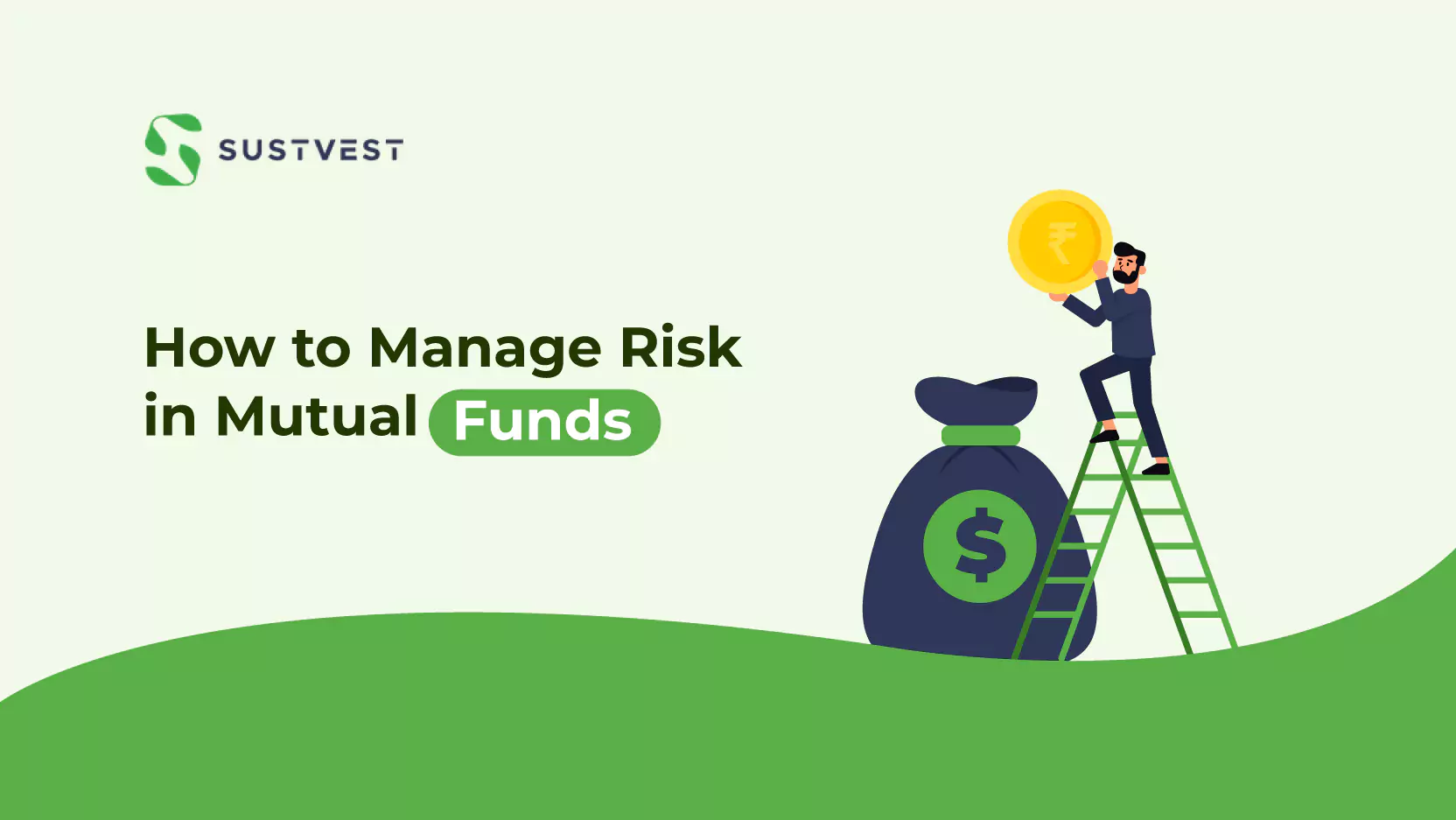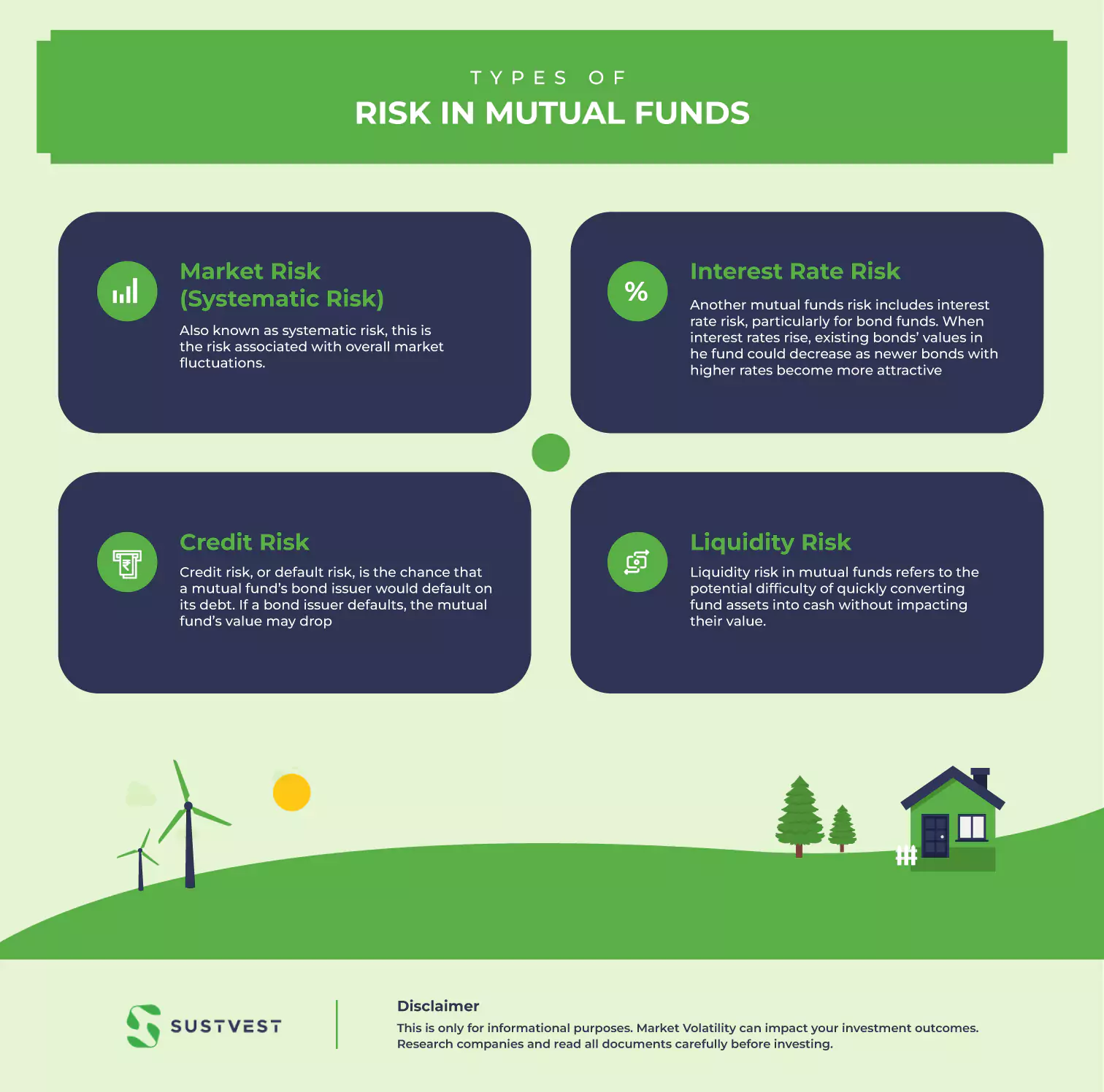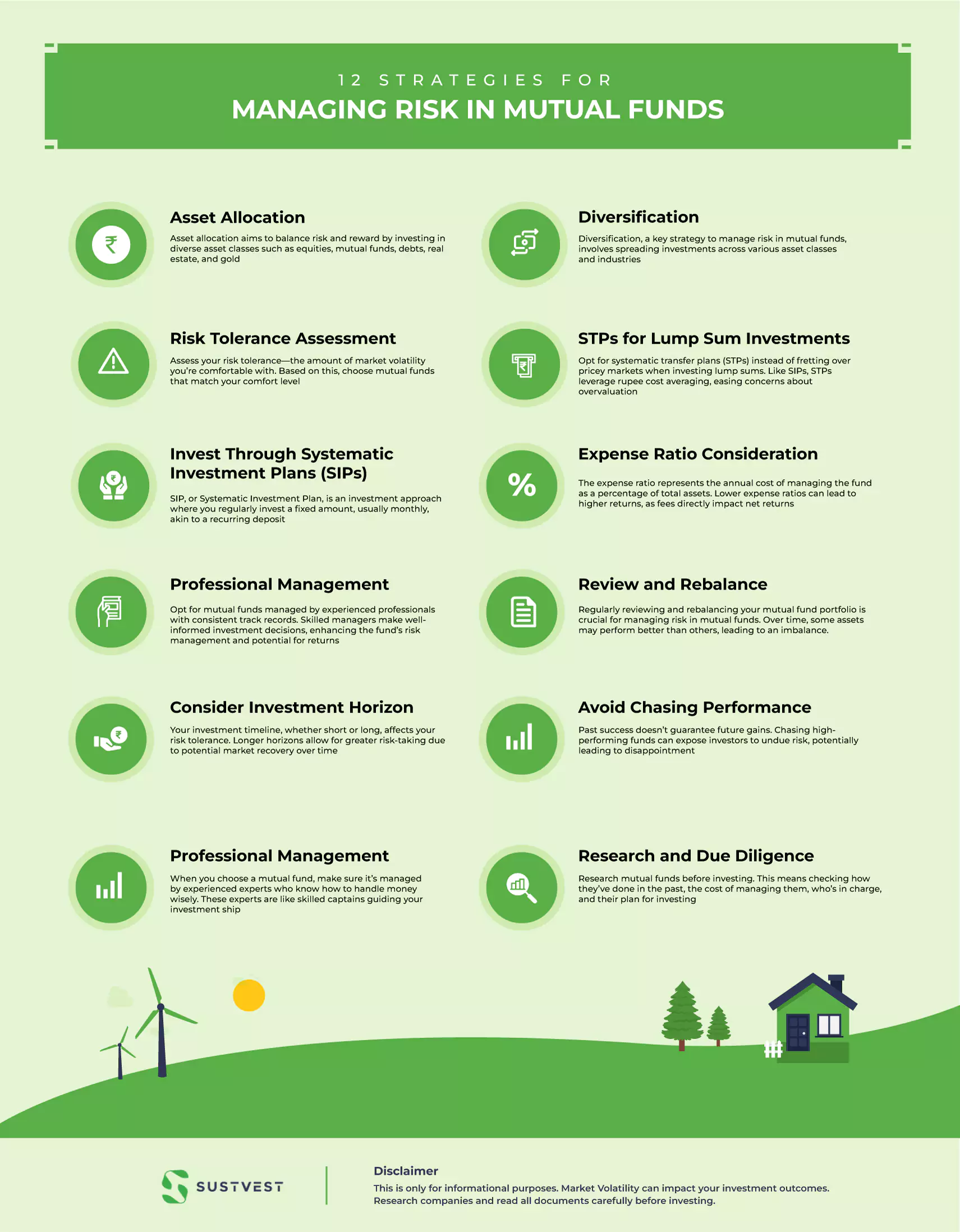You’ve heard about mutual funds and their popularity, but you’ve also heard whispers about risks. Those whispers are right!
There’s a thing called risk in mutual funds, and it can seem like a confusing maze to navigate.
But don’t worry! You’re about to take a simple and clear journey through this maze.
We’re going to explore how you can handle these risks without needing a finance degree. Together, we’ll look at some easy-to-follow strategies that will help you become confident in managing the risk in mutual funds.
It’s like putting on a safety belt before a fun ride.

Why Is Mutual Fund Investment Risky?
The inherent risk in mutual funds originates from their diverse investment in instruments like debt, equity, and bonds, which are susceptible to fluctuations due to various factors. This often leads to a decline in Net Asset Value (NAV), potentially causing losses for investors.
To harness the risk-reward balance, understanding mutual fund risks is crucial. It allows investors to navigate potential pitfalls and optimise their investments.
While mutual funds have their challenges, there’s always an alternative to explore. Have you considered the Best Alternative to Mutual Funds for your portfolio?
Types of Risk in Mutual Funds
Mutual fund risks can be broadly classified as systematic (market-related) and unsystematic (specific to a fund). Types of investors risk include:
1. Market Risk (Systematic Risk)
Also known as systematic risk, this is the risk associated with overall market fluctuations.
Factors such as economic conditions, geopolitical events, and market sentiment can impact the value of the entire market and consequently affect the value of mutual fund holdings.
2. Interest Rate Risk
Another mutual funds risk includes interest rate risk, particularly for bond funds. When interest rates rise, existing bonds’ values in the fund could decrease as newer bonds with higher rates become more attractive.
This shift can lead to potential losses for investors, highlighting the need to assess mutual funds’ interest rate sensitivity before investing.
3. Credit Risk
Credit risk, or default risk, is the chance that a mutual fund’s bond issuer would default on its debt. If a bond issuer defaults, the mutual fund’s value may drop.
This risk arises from the potential inability of the issuer to honour interest payments or repay the principal amount, leading to potential losses for the fund and its investors.
4. Liquidity Risk
Liquidity risk in mutual funds refers to the potential difficulty of quickly converting fund assets into cash without impacting their value.
This risk arises when a fund holds illiquid investments, hindering its ability to meet high investor redemption demands.
Such situations can lead to unfavourable sales and affect returns, underscoring the importance of managing liquidity risk in mutual fund investments.

12 Strategies for Managing Risk in Mutual Funds
Managing risk in mutual funds is essential to ensure the preservation of capital and the achievement of long-term investment goals.
Here are some strategies to consider:
1. Asset Allocation
Asset allocation aims to balance risk and reward by investing in diverse asset classes such as equities, mutual funds, debts, real estate, and gold.
Choose assets aligned with goals: short-term favours debt funds, and long-term favours equities. Tailor based on duration and risk tolerance for optimal investment choice.
2. Diversification
Diversification, a key strategy to manage risk in mutual funds, involves spreading investments across various asset classes and industries.
By doing so, the impact of poor performance in a single area is minimised. This approach reduces the overall vulnerability of the portfolio to market fluctuations and specific risks associated with any one sector.
When diversifying your mutual fund portfolio, consider three key elements:
- Avoid over-concentration in a single sector by investing in various sectors. Rather than solely relying on sector-specific or thematic funds, which increase risk, create a mix of sectoral, contra-equity, and focused equity funds.
- Balance your portfolio with large, mid, and small-cap funds to benefit from different market capitalisations’ advantages.
- Invest in asset classes that have a low correlation to each other. This helps reduce overall portfolio risk, as assets respond differently to market changes, enhancing your risk management strategy.
Diversification helps mitigate the potential negative impact of concentrated investments and provides a more balanced risk exposure across the entire portfolio.
3. Risk Tolerance Assessment
Assess your risk tolerance—the amount of market volatility you’re comfortable with. Based on this, choose mutual funds that match your comfort level.
Conservative investors might lean towards lower-risk funds, while those comfortable with fluctuations might opt for higher-risk options.
Adapting your investments to your risk tolerance helps avoid emotional decision-making during market swings and promotes a more aligned, stable portfolio.
4. STPs for Lump Sum Investments
Opt for systematic transfer plans (STPs) instead of fretting over pricey markets when investing lump sums. Like SIPs, STPs leverage rupee cost averaging, easing concerns about overvaluation.
They’re ideal as long-term goals approach, allowing smooth equity-to-debt fund shifts, curbing downside risk, and securing gains.
5. Invest Through Systematic Investment Plans (SIPs)
SIP, or Systematic Investment Plan, is an investment approach where you regularly invest a fixed amount, usually monthly, akin to a recurring deposit.
Yet, unlike deposits, each installment buys fund units valued at your fixed amount and current Net Asset Value (NAV). Regrettably, many mistake SIP as a product when it’s truly an investment method. It’s optimal for long-term investment due to rupee cost averaging.
Its brilliance lies in buying fewer units when markets rise and more when they dip. This eliminates market timing stress, reduces risk, and simplifies equity investing. Not utilising SIP means missing a wonderful tool for equity investment.
6. Expense Ratio Consideration
The expense ratio represents the annual cost of managing the fund as a percentage of total assets. Lower expense ratios can lead to higher returns, as fees directly impact net returns.
Prioritising funds with lower expense ratios can contribute to more favourable long-term investment outcomes by minimising the drag of fees on your overall returns.
7. Professional Management
Opt for mutual funds managed by experienced professionals with consistent track records. Skilled managers make well-informed investment decisions, enhancing the fund’s risk management and potential for returns.
Look for managers who follow disciplined approaches, which increase the likelihood of effective risk control and optimised performance over time.
8. Review and Rebalance
Regularly reviewing and rebalancing your mutual fund portfolio is crucial for managing risk in mutual funds. Over time, some assets may perform better than others, leading to an imbalance.
Rebalancing involves selling a portion of the overperforming assets and reallocating those funds to underperforming ones.
This practice helps you maintain your desired risk level and asset allocation. This can ensure that your portfolio remains aligned with your long-term goals and risk tolerance.
9. Consider Investment Horizon
Your investment timeline, whether short or long, affects your risk tolerance. Longer horizons allow for greater risk-taking due to potential market recovery over time.
This means that if you are investing for the long term, you might tolerate more volatility, aiming for higher returns.
However, if your investment horizon is shorter, you’ll likely prefer less risky options to safeguard capital since there’s less time to recover from market downturns.
Align your risk level with your investment horizon to strike a balance between potential returns and capital preservation.
10. Avoid Chasing Performance
Past success doesn’t guarantee future gains. Chasing high-performing funds can expose investors to undue risk, potentially leading to disappointment.
Instead, focus on a fund’s underlying qualities, like its strategy, management team, and alignment with your goals.
Prudent investors make decisions based on a holistic understanding of a fund’s merits, considering the long-term potential rather than short-lived successes.
This approach promotes a more balanced and rational investment strategy, mitigating the impulse-driven risks associated with chasing fleeting market trends.
11. Professional Management
When you choose a mutual fund, make sure it’s managed by experienced experts who know how to handle money wisely. These experts are like skilled captains guiding your investment ship.
Look for funds where the managers have a good history of making smart decisions. It’s like picking a team of champions to play for you. Skilled managers can help protect your money during tough times and make it grow over the long run.
So, before you invest, check who’s steering the ship and see if they have a record of making good choices.
12. Research and Due Diligence
Research mutual funds before investing. This means checking how they’ve done in the past, the cost of managing them, who’s in charge, and their plan for investing.
This helps you make sure the fund has a good history and that the people managing it are skilled.
By doing this, you can feel more confident that the fund you pick is a good fit for your goals and won’t be too risky.
Your research shouldn’t stop at mutual funds alone. When comparing options, dive into our Choosing Between Mutual Funds and Smallcase: A Guide to Smart Investments.

FAQs On Risk In Mutual Funds
What is the first step to manage risk in mutual funds?
Begin by diversifying your investments across various asset classes to minimise the impact of a single underperforming fund.
How can I assess a mutual fund’s risk level?
Look at its historical performance, volatility, and standard deviation.
Can timing the market help mitigate risk in mutual funds?
Timing the market is risky; focus on long-term goals and stay invested.
Are there low-risk mutual funds available?
Yes, low-risk funds exist, usually investing in stable assets like bonds or dividend stocks.
Conclusion
Effectively managing risk in mutual funds is paramount for investors seeking stable returns. Diversification, thorough research, and understanding of risk profiles are key strategies.
Regular review and adjustment of portfolios also play a pivotal role.
As you refine your strategy, it’s worth exploring diverse avenues. Here’s an intriguing one: 5 Reasons Why You Should Consider Green Investment in India.
For a sustainable investment approach focused on managing Risk in Mutual Funds, explore SustVest’s offerings today. Your financial future deserves prudent planning.

Founder of Sustvest
Hardik completed his B.Tech from BITS Pilani. Keeping the current global scenario, the growth of renewable energy in mind, and people looking for investment opportunities in mind he founded SustVest ( formerly, Solar Grid X ) in 2018. This venture led him to achieve the ‘Emerging Fintech Talent of the Year in MENA region ‘ in October 2019.




